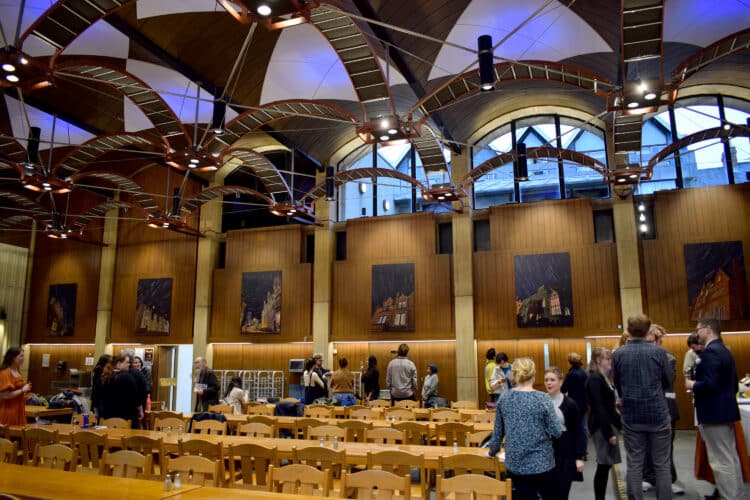Timeless: Teddy Hall under the Stars Exhibition
22 Oct 2025

St Edmund Hall hosted the launch of its first astrophotography collection by student Sarah A. Savić Kallesøe (2022, DPhil Population Health) on Friday 17 October in Wolfson Hall. Around 80 members and friends attended to view ten striking aluminium prints (1.5m x 1.2m) depicting Teddy Hall landmarks—from the Church Library and William R. Miller Building to the Front Quad and Norham Gardens—captured beautifully under the night sky.
The evening began with drinks as guests explored the photographs displayed along the panelled walls of the dining hall, before hearing welcoming remarks from Principal Katherine Willis. Attendees were also invited to browse an accompanying booklet describing each piece and to take home commemorative postcards.
Professor Jonathan Yates, Chattels and Pictures Fellow at the Hall commissioned Sarah to produce a permanent exhibition for the Hall and explained that whilst it is traditional for Oxbridge dining halls to have portraiture, Teddy Hall opted for a different approach to display the breadth of the Hall estate. Reflecting on the collection, Professor Yates remarked: “There’s also something about the stars that reminds us about the timelessness of Oxford places… if you look at the pictures over there of St Peter-in-the-East and you see the way the star patterns are… they would have been the same star patterns that St Edmund of Abingdon would have looked at 900 years ago when he looked over St Peter-in-the-East. And it will be the same star patterns that generations of Teddy Hall students will see in centuries to come. There’s something timeless about these pictures.”
The evening concluded with many thanks from Sarah to the Hall community for supporting the project and celebrating its unveiling.
Below is a summary from Sarah of how the photography was taken and the idea behind it in more detail:
“When I first began experimenting with astrophotography ten years ago, I was captivated by the idea that a camera could reveal what the eye alone cannot. Long exposures gather starlight over hours, unveiling constellations, galaxies, and colours invisible to the naked eye. The process requires patience, planning, hours beneath the stars, and meticulous editing, but the reward is a glimpse into the vastness of the night sky.
Although my academic work is in public health and bioethics, I continued to moonlight as an astronomer. During my undergraduate studies at Simon Fraser University in Canada and my master’s at Cambridge, I had access to observatories where I practiced capturing images of deep space. Arriving at Oxford, I could not find my way into an observatory, which proved a blessing in disguise. It encouraged me to adapt my skills and explore wide-field photography with more accessible equipment. Using a phone camera, tripod, and editing software, I learned to create something new: images of historic buildings framed by star trails.
This fascination became the foundation of a new permanent exhibition now on display in the Hall. Since February 2025, I have been working with Dr Jonathan Yates, the College Picture Fellow, to co-create a ten-piece collection featuring Teddy Hall under the night sky. Each photograph captures a different facet of college life, from the central quad and quiet library nights to the main entrance and off-site accommodation, all woven together with the stars above.
My process is part art, part science. Each image begins with research: scouting locations in daylight, checking forecasts, and planning around the Moon’s brightness. When conditions align, I spend hours on site capturing hundreds of exposures of both sky and foreground. Editing is then the work of weaving these layers together into a balanced image, ensuring the stars shine clearly while the college remains warmly illuminated.
This collection aims to place Teddy Hall in perspective: a reminder that our community, though rooted in history and tradition, is also part of something far larger and more enduring.”
Teddy Hall congratulates Sarah on this wonderful addition to the College for students, Fellows, staff and alumni to enjoy for many years to come.
Teddy Hall Under the Stars
Photo credit: A bespoke astrophotography collection by Sarah A. Savić Kallesøe (2022, DPhil Population Health)
See more at oxfordbynight.square.site or on Instagram at www.instagram.com/oxford_by_night
Categories
Related News

